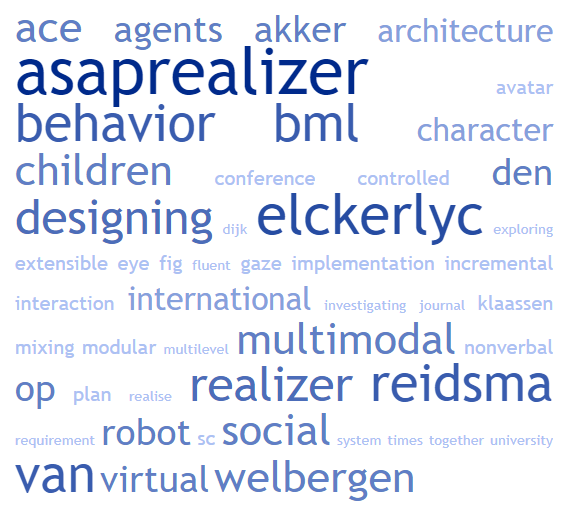
Notes:
Elckerlyc and AsapRealizer are software frameworks for behavior realization, which is the process of generating and controlling the behaviors of virtual characters or agents. Elckerlyc is a behavior realization framework that is designed to be modular and extensible, allowing developers to easily create and customize behavior models. It is implemented in Java, and supports a wide range of behaviors and interaction styles. AsapRealizer is another behavior realization framework, developed by the same research group as Elckerlyc. AsapRealizer is designed to be more efficient and scalable than Elckerlyc, and is optimized for real-time applications. Both frameworks can be used to create realistic and engaging behaviors for virtual characters, and can be integrated with other AI technologies, such as natural language processing or facial animation.
Resources:
- articulatedsocialagentsplatform/asaprealizer .. bml realizer for incremental, fluent, multimodal interaction
- asap-project.ewi.utwente.nl .. asap-project.org
See also:
Elckerlyc & BML (Behavior Markup Language)
AsapRealizer in practice–A modular and extensible architecture for a BML Realizer
D Reidsma, H van Welbergen – Entertainment computing, 2013 – Elsevier
… In the next chapter we will explain each requirement in more detail and show how each was solved in Elckerlyc and AsapRealizer; after that, we will compare our solutions to related state-of-the-art systems. • It should be possible to integrate new renderers.
An incremental multimodal realizer for behavior co-articulation and coordination
H Van Welbergen, D Reidsma, S Kopp – International Conference on …, 2012 – Springer
… Fig. 2 illustrates how we have incorporated design features from ACE and Elckerlyc into AsapRealizer. We make use of BML to specify behavior, enhanced BehaviorPlanner BML BML BML BML … AsapRealizer ACE Fig. 2. The design of Elckerlyc, ACE and AsapRealizer Page 6 …
AsapRealizer 2.0: The next steps in fluent behavior realization for ECAs
H Van Welbergen, R Yaghoubzadeh… – … Conference on Intelligent …, 2014 – Springer
… Unlike AsapRealizer, ACE, and Elckerlyc, each of these realizer has a rigid underly- ing behavior plan representation … EMBOT AsapRealizer realizer Greta SmartBody ACE Elckerlyc 1.0 2.0 Incremental plan construction Merging increments
Entertainment Computing
BML Realizerq – 2013 – herwinvanwelbergen.nl
… Keywords: Elckerlyc AsapRealizer Behavior Markup Language Virtual human Embodied conversational agents Architecture System integration Customization abstract … AsapRealizer, successor to Elckerlyc and ACE, is a state-of-the- art Behavior Realizer for virtual humans …
Multimodal plan representation for adaptable BML scheduling
H van Welbergen, D Reidsma, J Zwiers – Autonomous agents and multi …, 2013 – Springer
… This scheduling approach has been implemented in Elckerlyc’s successor AsapRealizer; we refer the interested reader to [15] for implementation details. Our current implementation only shifts the start time of speech behaviors, their inner timing is left unmodified. Fig. 6 figure6 …
In the eye of the wizard: effects of (mutual) gaze on an avatar mediated conversation
B Gennep – 2013 – essay.utwente.nl
… 4.2.3 ElckerlycComponent The ElckerlycComponent animates the avatar. It uses components of the AsapRealizer [1] (formerly Elckerlyc) to do this. The component receives the data from the FaceMirrorComponent and applies it to the avatar …
Things that Make Robots Go HMMM: Heterogeneous Multilevel Multimodal Mixing to Realise Fluent, Multiparty, Human-Robot Interaction
NCEDD Reidsma – researchgate.net
… We tackled this challenge by designing a framework which can mix these two types of behaviour, using AsapRealizer, a Behaviour Markup Language realiser. We call this Heterogeneous Multilevel Mul- timodal Mixing (HMMM) … 2) Flipper 3) AsapRealizer 4) Agent control …
Investigating the role of social eye gaze in designing believable virtual characters
M Nixon – 2017 – summit.sfu.ca
Page 1. Investigating the Role of Social Eye Gaze in Designing Believable Virtual Characters by Michael Nixon M.Sc., Simon Fraser University, 2009 B.Sc., Vancouver Island University, 2004 Thesis Submitted in Partial Fulfillment of the Requirements for the Degree of …
Exploring children’s use of a remotely controlled surfacebot character for storytelling
A Catala, M Theune, D Reidsma, S ter Stal… – International Conference …, 2017 – Springer
… 7(1), 5–16 (2014)CrossRefGoogle Scholar. 9. Klaassen, R., Hendrix, J., Reidsma, D., op den Akker, R., van Dijk, B., op den Akker, H.: Elckerlyc goes mobile … Reidsma, D., van Welbergen, H.: AsapRealizer in practice – a modular and extensible architecture for a BML realizer …
Exploring Children’s Use of a Remotely Controlled Surfacebot Character for Storytelling
S ter Stal, D Heylen – … INTETAIN 2017, Funchal, Portugal, June 20 …, 2018 – books.google.com
… 7 (1), 5–16 (2014) 9. Klaassen, R., Hendrix, J., Reidsma, D., op den Akker, R., van Dijk, B., op den Akker, H.: Elckerlyc goes mobile-enabling natural interaction in … Reidsma, D., van Welbergen, H.: AsapRealizer in practice–a modular and extensible architecture for a BML realizer …
Nonverbal behavior in multimodal performances
A Cafaro, C Pelachaud, SC Marsella – The Handbook of Multimodal …, 2019 – dl.acm.org
Page 1. 6Nonverbal Behavior in Multimodal Performances Angelo Cafaro, Catherine Pelachaud, Stacy C. Marsella 6.1 Introduction The physical, nonverbal behaviors that accompany face-to-face interaction convey a wide variety …
Designing a social robot to support children’s inquiry learning: A contextual analysis of children working together at school
DP Davison, FM Wijnen, J van der Meij… – International journal of …, 2019 – Springer
Page 1. International Journal of Social Robotics https://doi.org/10.1007/s12369-019-00555-6 Designing a Social Robot to Support Children’s Inquiry Learning: A Contextual Analysis of Children Working Together at School Daniel …
Virtual coaches for healthy lifestyle
HJA op den Akker, R Klaassen, A Nijholt – Toward Robotic Socially …, 2016 – Springer
Since the introduction of the idea of the software interface agent the question recurs whether these agents should be personified and graphically visualized in the interface. In this chapter we…